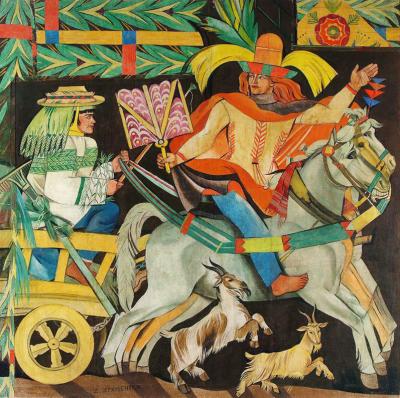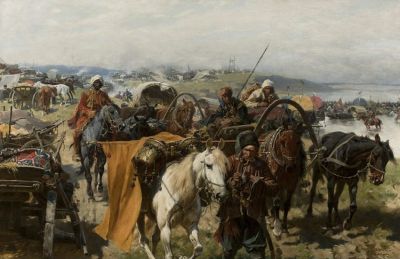Stryjeńska, Zofia

After marrying again, changing religion and moving, (Warsaw, 1929-30 Vilnius), during the Second World War she lived in Kraków and Poronin. In 1946, to avoid the state appropriating her art, she emigrated to Switzerland, then travelled through Europe, lived in Paris from 1951 to 1960 and in Geneva from 1962, where she died largely forgotten and in poverty. – It appears evident that Stryjeński had been influenced in Munich by Wassily Kandinsky’s colourful and two-dimensional figure compositions, and particularly by his religious compositions grounded in folk art ("All Saints’ Day", "St Vladimir", both 1911). According to Anna Król (2020), however, her style is particularly "associated with the search for a [Polish] national style and this was certainly one of the reasons it was so popular". From her first exhibition in 1912, where she showed the cartoons that she had created whilst still in Munich, she was considered a “creator of national art” in Poland, and in the 1920s, in the resurrected Polish state, she was seen as a "representative of the folkloric variant of Art Déco" (ibid). From today’s perspective, her broad areas of work encompassing free, decorative and applied art can be understood as a contribution to the pursuit for the complete work of art. In her paintings, which are mostly in opaque colours on paper or board and less frequently in oil on canvas, she combines narrative, figurative imagery with a geometric style and rhythmical surface composition in bright colours. She borrowed a humorous, and sometimes grotesque concept of man from folk art. Along with patriotic representations relating to the aim for or recently achieved Polish independence, which also appear in religious subjects, her work is dominated by representations of Polish rituals, customs and traditions dating far back in history. She studied traditional Polish costumes and was fascinated by the Slavs’ world of Gods and beliefs. In her portfolio "Bożki słowiańskie/Slavic Gods" (1918), she developed her own iconography which she reverted to in paintings, illustrations and stage sets in the decades that followed. Her work for the theatre was much more satisfying to her than ‘free’ painting and included the drama "Balladyna" (1835) by Julius Słowacki (1809-1849) to mark the transportation of the poet’s remains to the Wawel (1927) and costumes for the ballet "Harnasie" (1935) by the composer Karol Szymanowski (1882-1937). In her book art, she illustrated Polish authors and created bibliophile editions. She developed a series entitled “Polish dances” for postcards and advertising (chocolate packaging). The toys created by her were dominated by colourful building blocks and wooden figures ("Wawel dragon"). In textiles, she created kilims, batik work and clothing fabrics. She supplied designs to the porcelain factory in Ćmielów. Her works, which were mass produced, were also used in schools to reassess folk art and history. Her works can be found in the National Museums in Kraków, Poznań, Warsaw and Wrocław and in numerous Polish museums and libraries. At the Berlin Biennale in 2008, the Polish painter Paulina Ołowska (*1976, 2015 Aachen art prize) exhibited pictures from her own series "Zofia Stryjeńska" together with some of her predecessor’s work. A painted floor work made reference to the Polish Pavilion designed by Stryjeńska in Paris in 1925.


![In the Park/W parku, Munich or Lwów 1910. Watercolour over pencil on board, 46 x 33 cm, signed bottom right: Stefanowicz [1]910, at auction (Agra Art, Warsaw 2019) In the Park/W parku, Munich or Lwów 1910. Watercolour over pencil on board, 46 x 33 cm, signed bottom right: Stefanowicz [1]910, at auction (Agra Art, Warsaw 2019)](/sites/default/files/styles/width_100_tiles/public/Stefanowicz%20Kajetan.jpg?itok=BqYT6lfQ)
